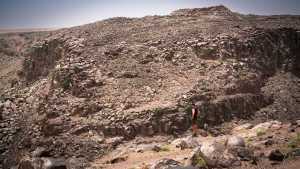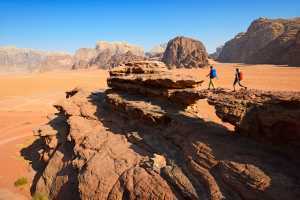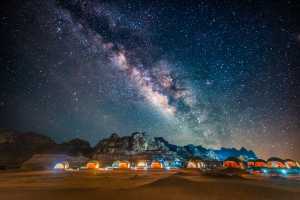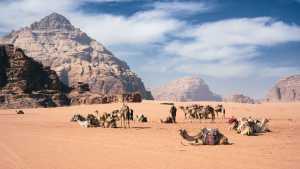Striking out from a shelter clad in plastic tarpaulins, eight dogs flow over the arid earth like liquid mercury. They course between black boulders on the gravel plain, snouts rimed with saliva, teeth bared and gnashing, emitting guttural, murderous tones.
There’s not much that I can do except square up to them, clap my hands and holler, which keeps them at bay for a minute, but it’s a low, lazy-sounding whistle from a Bedouin woman at a nearby tent that calls them to heel.
They range around her in a semicircle and sit placidly, awaiting her command. It’s possibly a stretch of the imagination, but the small display of authority seems to reverberate with an older, more resilient way of living.
The word Bedouin comes from the Arabic badawī, which means ‘desert dweller’, and historically they’ve lived in bayt al-sha’ar, a type of tent traditionally made from goat hides in Jordan, which is why it translates as ‘house of hair’ (now, they’ve largely been replaced by high-density polyethene).
Camels in Wadi Rum
Nick Savage
These traditions endure, even as the material world shifts around them. Her calm, almost indifferent reaction lingers in my mind. I’m attempting to find an access point to run down into Wadi Balua, one of the tributaries of the massive Wadi Mujib in Jordan and one of its rare basalt canyons. Admittedly, I feel like a bit of a tool for disturbing the dogs and the woman.
However, as I find out, the Jordanian Bedouins are nothing if not hospitable. In fact, it’s sacred to them. As I jog along the mouth of Wadi Balua, I spy my guide Yazan Hijazien chatting with Manhel Zayyadin on the opposite side. Zayyadin led us to this secluded viewpoint far from the tourist trail.
Both Hijazien and Zayyaddin trace their Christian Bedouin ancestry to the nearby Karak Valley area, to a village named As-Simakyah, where their grandparents lived in adjacent houses.
I watch the enormous chasm open like a book on its spine
The pair stand next to the Khirbat al-Balua, an Iron Age Moabite castle built from rectangular slabs of igneous rock, which, according to Hijazien, was constructed in the 14th century BC and is where the Balua Stele was discovered.
Like Petra and many of the historic sites in Jordan, the fortified citadel would have played host to a panoply of civilisations, from the Israelites and Nabataeans to the Hellenistic Greeks and Romans.
Now, Khirbat al-Balua is devoid of visitors and fanfare; the only human being aside from us is a lone man riding a donkey through the defile, tending a flock of goats. Pottery shards from various empires glimmer around the 3,000-year-old monument, but there are very few living people, and no tourists.
I descend beyond it into Wadi Mujib and watch the enormous chasm – 410 metres below sea level at its nadir, flanked by 900-metre mountain buttresses – open inwards like a book on its spine.
Afterwards, Abu Temara – a cheerful, avuncular driver with a Super Mario moustache – motors us across the Karak Valley, through a rare verdant area where downy rolling fields of wheatgrass are interspersed with Aleppo pine, acacia and olive trees, and herds of sheep and goats gambol under their branches.
As we crest the hills and descend into the old crusader stronghold of Kerak, the landscape gives way to stone and shadow.

Running the Wadi Balua canyon
Stephanie Highland
I get my first taste of mansaf after a windswept walk through Kerak Castle, a Christian fortress built in 1142 AD, perched on top of a vertiginously steep hill.
At Saraya Restaurant, golden late-afternoon light lances across the limestone battlements and through the window as a massive silver platter is shuttled onto the table behind us. We crowd around it as the cover is removed.
Steam clears to reveal an entire lamb, its flesh falling off the bone into a bed of fluffy yellow saffron rice and shrak, a type of flatbread, with a handsome sprinkling of golden roast almonds. Jameed, a fermented yoghurt reconstituted into a sauce, is decanted over it.
“The guest is God.” Hijazien explains that in Bedouin culture, God would have sent you a guest as a test of one’s generosity. “People are bonded through food. When you invite them to eat within your house, you become allies.” In Arabic, ḍiyāfa refers to a deeply rooted cultural and moral tradition combining hospitality and generosity.
It’s more than just channelling your inner Martha Stewart; it’s a sacred social contract codified through consumption. Hijazien demonstrates how to use one’s right hand to create a compact ball of rice and lamb.
Unfortunately, I scald my fingers on piping hot jameed sauce and, mortifyingly, fumble the food back into the tray, but Hijazien and Abu Temara laugh it off.
In an effort to redeem myself, I eat the lamb’s brain. Abu Temara uses the two jaw mandibles to click the skull open, and then wobbles the cerebrum toward my mouth on a broad spoon, accompanying it with a gluk gluk sound.
As one of the most prized parts of the animal, the head is considered a delicacy and a mark of respect, reserved for VIPs, and the brain is thought to symbolise wisdom and prestige.
I’ve had brain in various iterations, usually deep-fried, but never quite this unvarnished. Its mouthfeel is custard, and its flavour splits the difference between fish and mammal. It’s not the kind of thing I’d queue for back home, but after my earlier stumble, refusing would feel like turning down a blessing.

Hiking in Wadi Rum, Jordan
Norbert Eisele-Hein
The next morning, I’m desperate to burn brain calories, so it’s handy that I’m hiking 18km into Petra. We drive south to Shoubak, where I meet Eid Azzazmeh, a Bedouin man who has guided hikes in the region for 14 years. His family originally hailed from the southern deserts of Palestine, but drifted eastward.
Like many Bedouins, he grew up following a life of pastoral nomadism, living in tents and looking after his livestock, but is now settled and sedentarised in a permanent house. “I wish that I could go back to the tent so I wouldn’t have to pay taxes,” he says.
We descend onto a ragged dirt track north of the settlement of Jhair, and Abu Temara drives down steep switchbacks into yet another enormous canyon, Wadi al-Fayd.
At the trailhead, Azzazmeh shoulders a green nylon backpack then wraps and tightly binds a red-and-white keffiyeh around his head. The colours of his head garment gleam through the flat, overcast light.
We start the hike by dropping into a riverbed flanked by sheer walls of camel-coloured sandstone, jewelled with flowering purple nerium oleander, before beginning a 500-metre climb up the opposite side along a vast ridge.
Azzazmeh stops to indicate maple leaf-shaped impressions in a flat sheet of limestone. “Dinosaurs,” he says. Their footprints have been fossilised in the rock.
Moisture, like hospitality, is sacred
Threading our way between juniper trees, we wind up to a viewpoint overlooking Jebel As-Safa, where jagged dirks and scimitars of sandstone, limestone and alkali granite thrust into thin air. Between two ridges, we cast our gaze westwards between maroon mountains and across the Arabah Valley into Israel and the West Bank.
We are standing on the shoulder of the Jordan Rift Valley, itself a part of the Great Rift Valley system that runs from Lebanon to Mozambique.
Azzazmeh gestures for us to stop and kneels next to a small fire pit, then rifles through his rucksack to remove a blackened kettle.
It appears that we’re having mint tea on a mountaintop, yet another expression of Bedouin ḍiyāfah. We enjoy a lunch of hummus and fire-roasted flatbread together.
When I attempt to throw a banana peel into the fire, Azzazmeh patiently removes it from the flames.
Jordan is one of the five most water-stressed countries on the planet, with demand exceeding renewable supply by more than 30%. Moisture, like hospitality, is sacred. He sets the refuse aside, to be utilised by desert creatures.
We ramble southwards toward Petra, skirting a long spine, passing through Dalíesque sandstone rock formations that seem surprisingly suburban.
There are homey caves in the cliffs, and the stone seems to crumble away perfectly into retaining walls, bollards and cinder blocks. Though the landscape is still in a way that only truly remote places are, it’s hard to tell whether it was once settled.
This area has been inhabited since the Neolithic period, at least 9,000 years ago. When we emerge around the 1,200m-tall Jebel Proywe, we encounter a Nabataean residence, where a living space has been carved out of an outcropping, with a staircase hewn into its side.
I watch on in horror as one of their number leaps past me into the chasm
The next day, I wake up early to take the shuttle bus from the Petra Guest House hotel to Little Petra, and then run the seven-kilometre back trail into Jordan’s most famous archaeological site, passing similar ancient structures, camels and backpackers.
The majority of Petra was built by the Nabataean Kingdom – a wealthy Arab trading empire – before being taken over by the Greeks and Romans and then largely forgotten.
From 400CE, the Bedouins were known to be the stewards of Petra, and it was local Bedouins who led Swiss explorer Johann Ludwig Burckhardt to the site in 1812, when it was ‘rediscovered’ by Europeans.
The local B’doul tribe continued to reside in the ruins until as late as 1985, when Petra became a Unesco World Heritage Site, and were relocated to the nearby village of Umm Sayhoun, a few kilometres away.
Still, the Bedouin lifestyle is on full display, as I find when I run the stairway to the Ad Deir monastery, past a mind-boggling vista of ochre mountains signposted ‘the best view in the world’, and barrel headfirst into a herd of goats.
I watch on in horror as one of their number leaps past me into the chasm, the scrabble of its hooves against the rock like fingernails across a chalkboard (it probably had a preternatural goat sense of what I did to its cousin at the mansaf banquet in Kerak).
Only, as I turn, I find that it has averted disaster. It teeters precipitously on a tiny ledge next to the 20-metre drop. When its owner emerges from around the corner, he is none the wiser, smiling and waving amicably. Needless to say, I’m glad I didn’t kill his goat.
Petra may be a wonder of the ancient world, but for the Bedouins that live here, it’s always been part of the everyday, a place to sleep, eat, meet strangers and make money.
Some of the caves still bear soot from fires long since gone cold, as we find in the Uneishu Tomb, which, according to Hijazien, once contained the remains of Shaquilath, one of the Nabataean queens.
Tourism has irrevocably altered the region, but in between the boyfriends of Instagram dutifully taking staged photos, you’ll still see boys racing donkeys through slot canyons, grandmothers selling necklaces from repurposed tombs, and guides pointing out Nabataean temples as if they were giving you a tour of their own house.
A caravan of camels clad in colourful tassels and pom-poms lounge in a siq in the rock
Petra is easily one of the most interesting archaeological sites I’ve ever visited – at various times I experience the same frisson of excitement I had when cosplaying Indiana Jones as a youth – but the turnstiles and throngs of tourists make me crave emptiness, and I’m itching to reach Wadi Rum, the Valley of the Moon.
A few hours later, I arrive at Sun City, the first hotel in the Wadi Rum area to introduce geodesic dome tents. Set against the backdrop of a sandstone mesa, the effect is deeply Martian (incidentally, the Matt Damon hard sci-fi film of the same name was shot here).
On the first evening, I slip out into the desert for a few hours solo. The sand is a rich red and accretes around the rock, gathered and scalloped by Jordan’s powerful winds. I scramble onto one of the rock formations and peer out over the landscape. Below, a caravan of camels clad in colourful blankets, tassels and pom-poms lounge in a siq in the rock. A group of locals arrive in a convoy of 4x4s at an outlook to watch the sun set, ululating in excitement.
The next morning, we wake at dawn and ride camels for an hour as the sun splits across the eastern horizon. I’m a little apprehensive initially as my ride, at the back of the chain, seems to be the grumpiest quadruped of the lot, but when he jerks upright and starts plodding across the flats, he’s easygoing enough.
Watching their long shadows pour out over the sand, it recalls Salvador Dalí’s painting ‘The Elephants’, where strength and weight are perched upon impossibly fragile legs.

Bubble tents in Wadi Rum
When we return, I have the opportunity to meet Yanal Azawaida, our 29-year-old driver. “I was one of eight brothers and sisters and the only one born in a Bedouin tent,” he tells me. “There was only one car in my village which would go to a larger town to pick up provisions for the whole month. It had just left, so it wasn’t able to take me to the hospital, and I was born in the middle of Wadi Rum.”
Alongside running his own dark sky tourism company Stargaze Jordan, which blends stargazing and storytelling, he was the first Bedouin camera assistant and location manager in the area, and has acted in seven films.
He’s worked on many big-ticket projects, from Dune to John Wick, and has met some of the most famous (and infamous) people on the planet, including Zendaya, Salma Hayek, Timothée Chalamet and Elon Musk. The coolest and most down-to-earth, in his humble opinion? It’s Keanu Reeves, by a country mile.
We take off south in a Toyota Hilux. I sit on a bench in the bed of the pickup truck, which has been canopied with a traditional blanket; a bandana wrapped around my face to keep the dust out of my lungs. The red scene zips past.
Towering rock formations etched with ancient petroglyphs and Nabataean inscriptions ascend like fortresses from plains of sand. The heat is so dry that moisture evaporates from the skin, leaving only the powdery residue of salt.
We arrive at the tent of one of Hijazien’s long-time friends, Abdul Rahman Zawaideh, who runs a small farm with his wife, young son and daughter. He offers us a mansaf feast for lunch, which Hijazien squirms politely to decline, putting his hand over his heart and smiling appreciatively.
Landscapes, in childhood’s dream, were so vast and silent
It would take the rest of the day, and we’re on an itinerary. Instead, we enjoy fresh-from-the-earth watermelon, famous in the region, and for good reason. As its juicy flesh provides some well-received moisture, someone offers me a kid goat to hold. I watch the children play with the farm animals, a standoffish dog and dolorous donkey, before climbing back into the truck.
After running the Al Bara’a canyon, I pull up at a long dune, where I rejoin Azawaida and Hijazien and sit, our bare feet burrowed into the cooling subsurface of the sand. Hijazien creates a little pile of it and then drizzles water over the top to demonstrate how erosion works in the area – the miniature mound looks like a facsimile of the rock formations all around us.
Azawaida lets out a whoop, which resounds off five or six surfaces, various echoes playing out in stereo.

A caravan of camels clad in colourful blankets, tassels and pom-poms
Nick Savage
It brings to mind TE Lawrence, better known as Lawrence of Arabia, who wrote in Seven Pillars of Wisdom: “Our little caravan grew self-conscious, and fell dead quiet, afraid and ashamed to flaunt its smallness in the presence of the stupendous hills. Landscapes, in childhood’s dream, were so vast and silent. We were afraid of them. They were God-like and echoing.”
However, even in this vast, echoing landscape, the warmth of ḍiyāfa is pervasive. Squeezed from all sides by regional conflicts in Palestine, Syria and Iraq, Jordan has absorbed successive waves of displacement. At its peak, the country hosted more than four million refugees, over a third of its total population.
And yet, I’ve felt safer here than I often do in London, as if the entire country were a Bedouin tent. Even in its most remote canyons, a stranger is still treated as guest, and generosity flows as naturally as water: rare and sacred. Jordan may sit at a geopolitical crossroads, but in the cadence of ḍiyāfa, it feels like a sanctuary. Not untouched, but unshaken.
